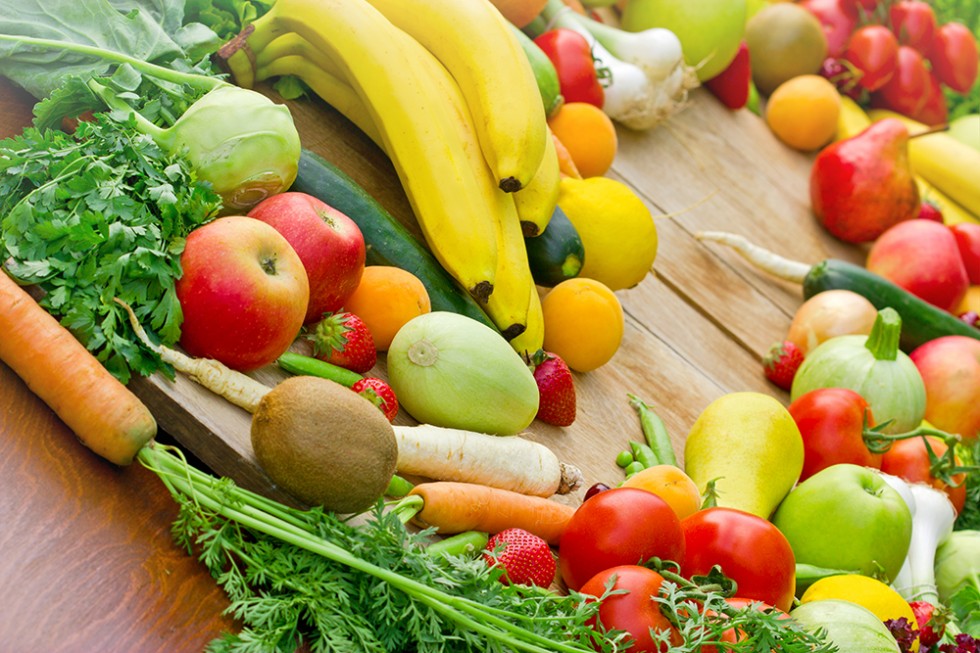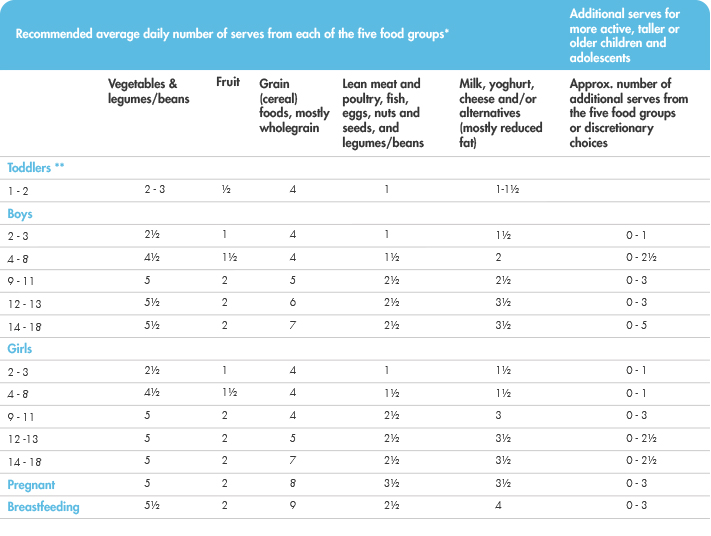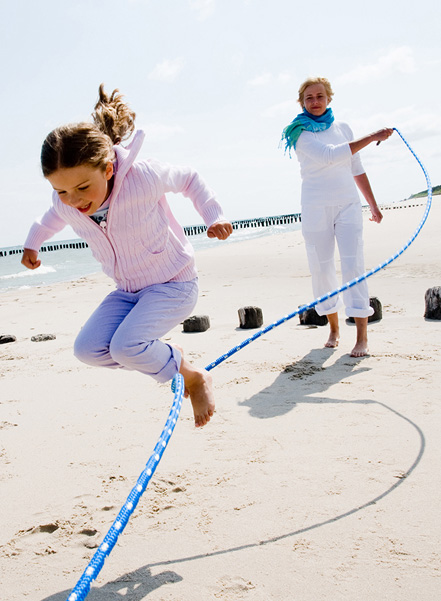The Five Food Groups

You might remember the Healthy Living Pyramid from your school days. The Australian Government has now suggested we should instead focus on the Healthy Living Plate. Whichever way you look at it, you need to make sure that you and your children are eating a balanced diet. You should be eating from the five food groups every day to ensure that you and your family are getting all the nutrients you need.
Your diet should consist of a wide variety of foods from these food groups every day:
- Plenty of vegetables of different types and colours, and legumes/beans
- Fruit
- Grain (cereal) foods, mostly wholegrain and/or high cereal fibre varieties, such as breads, cereals, rice, pasta, noodles, polenta, couscous, oats, quinoa and barley
- Lean meats and poultry, fish, eggs, tofu, nuts and seeds, and legumes/beans
- Milk, yoghurt, cheese and/or their alternatives, sometimes choosing reduced fat options for those over 2 years of age
- And drink plenty of water!
Because they are still growing and developing, infants, children and teenagers have special food needs. They also need extra energy for playing and being more active.
The best approach to make sure they are fit and healthy is to work together as a family to eat nutritious meals and engage in physical activity together. Why not head to the park together and kick a ball around or throw a Frisbee?
Try and keep some foods as special treats and make sure that they only appear sporadically.
When you’re going grocery shopping, only buy foods from the five food groups. It can be really helpful to plan your family’s meals for the week and use a list. When you’re cooking healthy meals, double the portions and freeze some for when you’re too busy to cook.
If you are on-the-go, our Squeezies are a handy way to make sure that your toddler is getting plenty of fruit and vegetables. And you should always keep some UHT milk in the fridge (and a spare in the cupboard!) to make sure everyone is getting his or her daily requirements of calcium

*Includes an allowance for unsaturated spreads or oils, nuts or seeds (½ serve [4.5g] per day for children 2-3 years of age, 1 serve [7-10g] per day for children 3-12 years of age; 1 ½ serves [11-15g] per day for children 12-13 years, and 2 serves [14-20g] per day for adolescents 14-18 years of age and for pregnant and breastfeeding girls).
** An allowance for unsaturated spreads or oils or nut/seed paste of 1 serve (7–10g) per day is included. Whole nuts and seeds are not recommended for children of this age because of the potential choking risk.
Tips for Eating Well
Healthy eating is important for the whole family, so it makes sense to plan meals that you can all enjoy together. By eating a variety of nutritious foods, you can make sure that everyone is getting the vitamins and minerals they need to thrive.
Make sure you eat regularly
If you aim for a regular pattern of meals and healthy snacks, you’re much more likely to be able to make healthy choices that will help to keep you in the best possible health. Adults should try and have 3 main meals and 3 healthy snacks throughout the day. Planning ahead means you should be able to eat the recommended number of servings from the 5 food groups.
Don’t skip breakfast!
It’s not called the most important meal of the day for no reason! Skipping breakfast makes you more likely to be tempted later in the day and more likely to reach for something that isn’t a healthy choice. If you’re in a rush, why not grab one of our meal replacement drinks. Other healthy choices include wholegrain cereal or bread, milk or yoghurt and a piece of fruit.
Eat with other people not TV
Make mealtimes social occasions. Get all the family together to sit down and talk about their day. You’re less likely to make unhealthy choices if you’re all sat down together around the table.
Persevere with toddlers!
Whilst toddlers can develop really fussy eating habits, it is worth keeping offering the healthy foods that the rest of the family enjoy. If you only have a variety of healthy options on offer, they will soon decide if they are willing to accept those choices. Snacks and school lunchboxes are the ideal time to include fruits, or maybe one of our handy squeezies.
Exercise & Health
 It’s so important to remain active at every stage of your life and there are lots of ways to have fun whilst improving your health.
It’s so important to remain active at every stage of your life and there are lots of ways to have fun whilst improving your health.
Regular physical activity can:
- Help prevent heart disease, stroke and high blood pressure
- Reduce the risk of developing type II diabetes and some cancers
- Help build and maintain healthy bones, muscles and joints reducing the risk of injury and
- Promote psychological well-being.
- Nutrition for everyday activity, nat. physical activity guidelines link
For children, being physically active every day is critical for healthy growth and development. At the infant stage, from 1 to 3 years, supervised floor play is a great form of exercise and should be encourage from birth. Encouraging infants to grab and reach for things, move their head to look around, push and pull are all beneficial forms of exercise.
Toddlers
Once children reach toddler age, they should be physically active every day for at least 3 hours, which can be spread thoroughly the day. Simple activities like standing up and moving around, as well as more vigorous activities like running and jumping are perfect, especially during shared active playtime. Television watching and use of console games should not be undertaken by children under 2 years, and severely limited for pre-schoolers.
Pre-Teens (5 – 12 year olds)
Pre-teens require a combination of vigour and moderate exercise daily. Brisk walking and bike riding or running should be regular activities, while participation in organised sports produces excellent health benefits and challenges children to achieve great athletic goals. Use of electronic media for entertainment should be discouraged over 2 hours.
Teenagers
At least one hour of physical activity per day is recommended for teenagers, from moderate to vigorous intensity. Children aged 12 – 18 have more variety of exercise available to them, such as bike riding, running, skateboarding, swimming and dancing. Team sport participation is encouraged, and at least 20 minutes of vigorous activity should be included at least 3 – 4 times a week.
Adults
Adults can combine a few simple steps with healthy eating to achieve greater fitness benefits:
- Move around as much as possible. It should be encouraged and not seen an inconvenience of time-waster
- Be active every day in as many ways as you can, e.g. walk or cycle to work
- Achieve at least 30 minutes of moderately intense physical activity per day
- Enjoy some other regular, vigorous activity such as yoga, swimming or jogging
Seniors
Older adults should not feel like it’s ‘too late’ to become active. Some form of physical activity is encouraged no matter what your age, health problems or other issues are.
Being active in many ways such as cardio, strength, balance and flexibility is most beneficial to older adults. At least 30 minutes of accumulated exercise is encouraged on most, if not all days.
